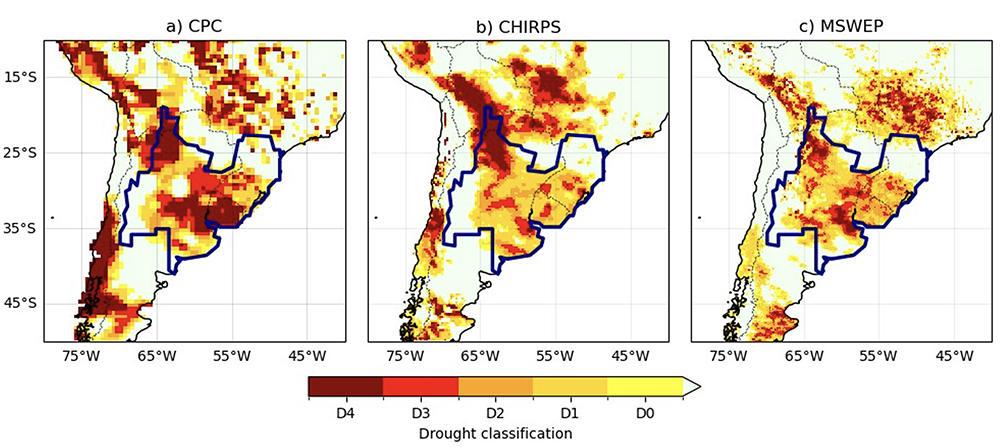Vulnerability and high temperatures exacerbate impacts of ongoing drought in Central South America
Since 2019 large parts of Argentina and neighboring countries have been reeling under drought conditions with the last four months of 2022 receiving only 44% of the average precipitation: the lowest rainfall in 35 years.
In October 2022, Uruguay declared an agricultural emergency (which was extended in time and scope in January 2023), and the subsequent deterioration in growing conditions is impacting already vulnerable farmers and residents in the agricultural heartland of the continent. Crop health in Argentina is reportedly the poorest in 40 years, with severe expected impacts on wheat and soybean harvests. Argentina already saw a 61 percent decrease in grain and oilseed export revenue between January 2022 and January 2023. Simultaneously to the drought, a series of record breaking heat waves, that a previous WWA study found are more severe due to climate change, is affecting the region. The ongoing heat exacerbates impacts of the drought on agriculture by e.g., putting heat stress in addition to water stress on crops.
Scientists from Argentina, Colombia, France, the United States of America, the Netherlands and the United Kingdom collaborated to assess to what extent human-induced climate change altered the likelihood and intensity of the low rainfall that led to drought, focussing on the particularly severe three months from October to December 2022.
Using published peer-reviewed methods, the team defined the event by the average precipitation during these three months for the region of largest impacts, outlined in blue in Figure 1, and analysed whether climate change altered the likelihood and intensity of the anomalously low rainfall. Given that the season was also characterised by multiple heatwaves (Rivera et al., 2022), the researchers additionally evaluated the effect of temperature, in particular, whether and to what extent climate change has influenced evapotranspiration, thereby exacerbating the drought.

Main findings
- The ongoing drought has led to severe impacts on agriculture, halving the annual harvests in wheat and soy in Argentina, which in turn is expected to lead to export deficits of 25-50%. The drought impacts hit the population on top of already high inflation and weakening local currency. In Uruguay, more than 75,000 people are suffering from lack of access to potable water; access to water for crops and livestock is also limited.
- Central South America has suffered from drought for the last three years, which saw consecutive La Niña There is a high correlation between the rainfall deficit in the study region during the months of October to December and the Niño 3.4 index. Thus, the rainfall deficit is in part driven by La Niña.
- In order to identify whether human-induced climate change was also a driver of the rainfall deficit, we analysed rainfall over the most impacted region and in 9 representative For the region as a whole, the event has a return period of 20 years, meaning it has a 5% chance of occurrence in any given year. At individual stations, it is a less common event, with return times up to 50 years.
- In the observations over the whole region we observed a trend of reduced rainfall over the last 40 years, although we cannot be confident that this trend is beyond what is expected from natural variability in the region.
- In order to identify whether the reduced rainfall is a real trend beyond natural variability that can be attributed to climate change, we looked at once in 20-year low rainfall events over the same region in climate models and found that the models show that low rainfall events decrease – ie they become wetter; the opposite of the trend observed in most weather records – although this trend is again not significant and is compatible with natural variability. Thus, we cannot attribute the low rainfall to climate change.
- This does not rule out that climate change affected other aspects of the drought. To investigate whether the high temperatures, which are in part attributable to climate change, led to a deficit in water availability, calculated as potential evapotranspiration subtracted from the rainfall, we repeated the analysis for this indicator.
- The results show that, in climate models, the increase in temperature does partly compensate for the increase in rainfall but only to offset the wettening, and does not lead to a significant climate change signal in effective precipitation..
- However, higher temperatures in the region, which have been attributed to climate change, decreased water availability in the models in late 2022, indicating that climate change probably reduced water availability over this period in the observations too, thus increasing agricultural drought, although the study cannot quantify this effect.
- This means even though the reduced rainfall is within the natural variability, consequences of drought are becoming more severe due to the strong increase in extreme heat.
- The high impact of the drought on agriculture and economic activity speaks to the need to reduce vulnerability to drought in this Measures such as improved water efficiency and management, anticipation of drought using seasonal forecasts, and insurance instruments to help farmers weather dry years could improve resilience to these types of events.